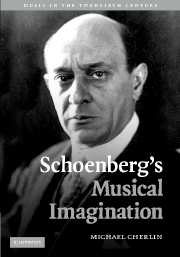Book contents
- Frontmatter
- Contents
- List of music examples and figures
- Acknowledgements
- Introduction
- 1 A passing of worlds: Gurrelieder as Schoenberg's reluctant farewell to the nineteenth century
- 2 Dialectical opposition in Schoenberg's music and thought
- 3 Dramatic conflict in Pelleas und Melisande
- 4 Motive and memory in Schoenberg's First String Quartet
- 5 Uncanny expressions of time in the music of Arnold Schoenberg
- 6 The tone row as the source of dramatic conflict in Moses und Aron
- 7 The String Trio: metaleptic Schoenberg
- Notes
- Bibliography
- General index – names and topics
- Index of Schoenberg's works and writings
7 - The String Trio: metaleptic Schoenberg
Published online by Cambridge University Press: 22 September 2009
- Frontmatter
- Contents
- List of music examples and figures
- Acknowledgements
- Introduction
- 1 A passing of worlds: Gurrelieder as Schoenberg's reluctant farewell to the nineteenth century
- 2 Dialectical opposition in Schoenberg's music and thought
- 3 Dramatic conflict in Pelleas und Melisande
- 4 Motive and memory in Schoenberg's First String Quartet
- 5 Uncanny expressions of time in the music of Arnold Schoenberg
- 6 The tone row as the source of dramatic conflict in Moses und Aron
- 7 The String Trio: metaleptic Schoenberg
- Notes
- Bibliography
- General index – names and topics
- Index of Schoenberg's works and writings
Summary
Something was burning. And besides,
At the far end of the room a discredited waltz
Was alive and reciting tales of the conquerors
And their lilies – is all of life thus
A tepid housewarming? And where do the scraps
Of meaning come from? Obviously,
It was time to be off, in another
Direction …
John Ashbery: “April Galleons”Introduction
Schoenberg composed his String Trio, op. 45, primarily during a period of convalescence following a nearly fatal heart attack that he suffered on August 2, 1946. Schoenberg's own recollections of the events of his illness as well as a discussion of their relevance to programmatic elements in the String Trio have been studied by Walter B. Bailey. Bailey describes the original commission for the trio, Schoenberg's initial conception of its form, and the relation of that conception to the finished work.
The dates on the manuscript of the Trio, 20 August – 23 September 1946, show that it was written largely during the period when Schoenberg was recovering from his heart attack. Leonard Stein, a frequent visitor in the Schoenberg home, recalls that Schoenberg worked on the score even before he was strong enough to leave his bed. The work, however, had been commissioned somewhat earlier by A. Tillman Merritt of Harvard University. In a letter of 28 May, 1946, Merritt asked Schoenberg to write a chamber composition of unspecified instrumentation for a concert that would accompany the “Symposium on Music Criticism” that Harvard would host the following May…. Schoenberg accepted the commission in a letter of 15 June 1946, where he noted that he had begun work on the score. […]
- Type
- Chapter
- Information
- Schoenberg's Musical Imagination , pp. 299 - 339Publisher: Cambridge University PressPrint publication year: 2007

